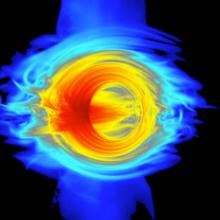
The group also collaborate with the Einstein Toolkit consortium, an open software community for numerical relativity and relativistic astrophysics to take advantage of petascale computers and advanced cyber infrastructure. The ET consortium includes over 200 researchers across the world. We also work together with computer scientists at the National Center for Supercomputing Applications to run and visualize our simulations on the Blue Waters supercomputer, one of the most powerful supercomputers in the world.
Current graduate student Kaitlyn Porter studies the radiative signatures of binary black hole systems. She is working with the general relativistic ray-tracing code, Bothros, which solves the path of light around these systems and can post-process GRMHD simulation data to calculate the EM emission coming from the disks around black holes. She is adapting this code to include an analytical accretion disk model, rather than running GRMHD simulations to calculate the temperature/flux of the disk material, which can be very computationally expensive. So through this analytical disk model, we get the intensity of light on the disk surface and then by tracking the geodesics from the disk to the observer we can produce images, light curves, and spectra of binary black hole systems.
For our studies of black hole mergers, we have used Spiegel, an in-house framework developed by Hans-Peter Bischof, which focuses on the data flow model to implement visualization systems. Most of these visualizations are used to promote research at RIT to the wider community, and for education or outreach purposes. One example is the AstoDance project which uses 3D visualizations to connect hard of hearing students with astrophysical phenomena and dance performances. Visualizations are also produced for the annual Imagine RIT exhibit, presentations to K-12 students, research seminars and colloquia given at RIT and at other institutions. A small selection of movies generated with this framework can be found here here.
We use software such as IDL as well as publicly available tools such as Python, SciPy, and VisIt to visualize our simulations of hydrodynamics simulations, e.g. magnetized gas around supermassive black hole systems. Because most of these simulations typically produce 1-10TB, with each 3D data set taking up ~10GB of space, we use HDF5 data format to store the data on our local CCRG cluster facilities, or on the Blue Waters system at NCSA.
Scientific visualizations fare also used to support a funded REU program on multi-messenger astrophysics, and programs at RIT's National Technical Institute for the Deaf to promote science to the deaf and hard-of-hearing communities. The cluster will also be a vehicle for public outreach events on science, mathematics, and computing through site visits and annual community-wide public exhibits.




